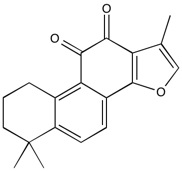Tanshinone IIA | AP-1 transcription factor inhibitor
NMR (Conforms)

Available Options
| Size : | Price | Quantity | |
|---|---|---|---|
| 5 mg | $50.00 | ||
| 25 mg | $140.00 |
Tanshinone IIA (568-72-9) is a diterpenoid naphthoquinone found in Salvia sp. and isolated as an active component of the traditional Chinese medicine Tanshen. Tanshinone IIA displays anti-inflammatory activity1 and induces apoptosis in a variety of cell lines2. Also inhibits AP-1 activity by suppressing jun-fos-DNA complex formation (IC50 = 0.22 μM)3.
References/Citations:
1) Kang et al. (2000), Inhibition of interleukin-12 and interferon-gamma production in immune cells by tanshinones from Salvia miltiorrhiza; Immunopharmacology, 49 355
2) Sung et al. (1999), Tanshinone IIA, an ingredient of Salvia miltiorrhiza BUNGE, induces apoptosis in human leukemia cell lines through the activation of caspase-3; Exp. Mol. Med., 31 174
3) Park et al. (1999), Suppression of AP-1 Activity by Tanshinone and Cancer Cell Growth Inhibition; Bull. Korean Chem. Soc., 20 925
NMR (Conforms)
Safety Data Sheet:
Product Data Sheet:
Materials provided by Focus Biomolecules are for laboratory research use only and are not intended for human or veterinary applications. Please note that we do not sell to individuals and that all orders placed by non-research organizations will incur a $20 restocking/refund fee
Tanshinone IIA (568-72-9) is a diterpenoid naphthoquinone found in Salvia sp. and isolated as an active component of the traditional Chinese medicine Tanshen. Tanshinone IIA displays anti-inflammatory activity1 and induces apoptosis in a variety of cell lines2. Also inhibits AP-1 activity by suppressing jun-fos-DNA complex formation (IC50 = 0.22 μM)3.
References/Citations:
1) Kang et al. (2000), Inhibition of interleukin-12 and interferon-gamma production in immune cells by tanshinones from Salvia miltiorrhiza; Immunopharmacology, 49 355
2) Sung et al. (1999), Tanshinone IIA, an ingredient of Salvia miltiorrhiza BUNGE, induces apoptosis in human leukemia cell lines through the activation of caspase-3; Exp. Mol. Med., 31 174
3) Park et al. (1999), Suppression of AP-1 Activity by Tanshinone and Cancer Cell Growth Inhibition; Bull. Korean Chem. Soc., 20 925
Related Transcription Factor Modulators
Download
Calculate the molar concentration, mass or volume in a solution.
Concentration × Volume × Molecular Weight = Mass
Focus Biomolecules • Plymouth Meeting, PA USA • 1-855-FOCUS21
Focus Biomolecules
Plymouth Meeting, PA USA
1-855-FOCUS21
Website Created by Advanta Advertising LLC.

